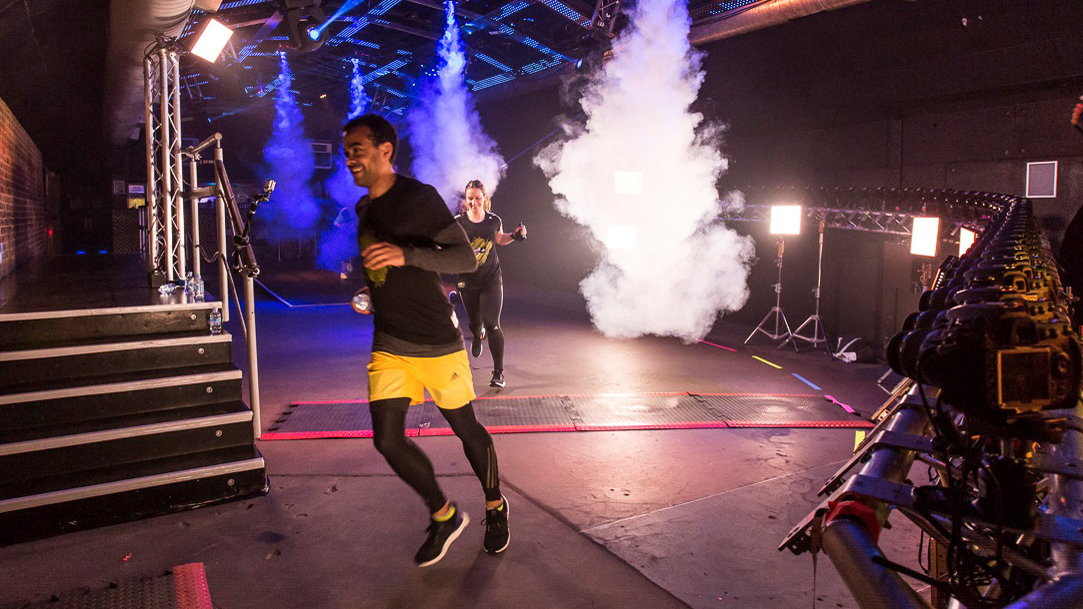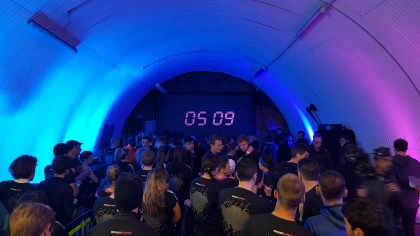A race into the night showed me the future of running
Sprinting through the streets got me thinking

There's something about running that creates a duality in most people, from the new runner to the most seasoned trotter.
On the one hand the feeling of oxygen in the lungs, the notion that you're actually doing something rather than festering on the sofa is brilliant and intoxicating.
But on the other, there's the fact running can actually suck. I've lost count of the times where I've had not had the foggiest idea what I'm doing slogging through muddy fields when I could be on the sofa eating a Twix.
So Adidas' 10K Energy Takeover run through London on a brisk Wednesday night left me conflicted: after a full day of trying to work out how good the latest Samsung phone is could I really be bothered to bash around the streets before getting the last train home from… wait, where was the finish?
The premise Adidas dangled enticed me as a technology fan: a run through London, but with no idea where we were going – the only way to work it out was through a compass that would spring to life on my smartphone when the clock struck eight o'clock.
That was the reason I was huddled with a couple of hundred other people in an rejigged carwash, watching a countdown flicker on a shutter until the moment it opened and we could stamp off into the night.

There was a twist on top of the unknown route too: divided into coloured groups, each runner was sent on one of three slightly different courses.
Sign up for breaking news, reviews, opinion, top tech deals, and more.
I'd arrived tooled up with a Sony Smartwatch 3 to let me use Google Maps, (along with the trusty Garmin 920XT) thinking that we'd be given a series of checkpoints I could key in and I could smugly watch as the competition carried a smartphone while I could just glance down at my wrist on occasion.
However, as it transpired I didn't need to worry. The link on my phone turned into a compass, and I duly began to follow it en route to 'Boost Location 1'.
Except… well… it didn't move. I waited a bit longer, glancing down at the Garmin to confirm it was still dutifully tracking location, that I was definitely running and not trapped in a static nightmare.
But nothing happened. I was going straight ahead with no idea when to turn.
Somehow the people ahead of me knew the route, so I cursed my phone for failing. I don't know if you've ever tried to reset a phone while running at 80% effort, but it's not easy. The worry I was going to smash this new handset added to a heart rate that was already peaking alarmingly.
Even with the restart, the compass steadfastly refused to change. After the herd ahead of me changed direction, I decided to just follow along… which is when I realised that we were just following coloured signs attached to lampposts as all the compasses had failed. Not the most high-tech, but at this point I was glad of any direction.
I tried to keep Google Maps open to gain a semblance of location, but it proved stupid as there was no pattern to follow.
I was really hoping I was going to get a chance to take some decent photos on this run, especially with the Samsung Galaxy S6 in my pouch. The impressive image stabilisation promised iPhone-esque levels of clarity for snaps when running, and when we entered the Kennington Oval cricket ground, it seemed like the perfect time.
Except as I was panicking about getting lost, I had to keep pace with the increasingly swift group in front of me, so the moment was gone.
And that's how the pattern played out for the next five miles: keep running, hope to see a sign, bemoan the phone for not making the compass work, hit a checkpoint. It was pretty cool legging it through London's backstreet at full pelt but frustrating when we missed a couple of signs.
It was really frustrating that the tech didn't work, as it was kind of the point of the whole run. I'd really been looking forward to my smartphone giving me another way to experience the city on foot.
But this run did give me a hint of what life for runners will become in the not-too-distant future. Having just tried Sony's SmartEyeglass technology, which brings augmented reality into your vision while exercising, it seems like a very small step to make these kinds of races into the darkness, with no knowledge of the route, a reality and without the backing of a large sports brand needed.
Imagine being able to just join a group on Facebook, meet at a given point, have an app decide on a finish line and auto-populate a route through a major city. GPS tracking could create real time leaderboards, giving full motivation and only your own will to push on, while smart eyewear shows you the turnings to take.
We don't need to technology to run. But man, it could make it awesome.
Is Apple actually getting it right?
Something caught my eye this week: it seems Apple might be offering up a better running watch than I previously thought. I've waxed lyrical already about the disappointing lack of GPS built in, that you need to connect the phone to use it properly on the go, but perhaps the Cupertino brand has done something smart to partly offset that.
According to Christy Turlington-Burns' diary of training for a marathon with the Watch, it can apparently read your stride pattern when out and about and connected to a phone, and match that with GPS to learn your speed and cadence.
Presumably this is accurate info, as while it's a journal of her running exploits it's hard to see Apple not fact checking what's written given it's publishing it on its own website.
That ability makes it much more accurate when running indoors or on the roads without the phone attached – while it's a long way from perfect, it's an interesting trick that I've not seen shouted about by other manufacturers.
Feel free to tell me how wrong I am about that in the comments below or on Twitter – and if anyone else competed in the same Energy Takeover race, I'd love to hear your experiences too.

Gareth has been part of the consumer technology world in a career spanning three decades. He started life as a staff writer on the fledgling TechRadar, and has grew with the site (primarily as phones, tablets and wearables editor) until becoming Global Editor in Chief in 2018. Gareth has written over 4,000 articles for TechRadar, has contributed expert insight to a number of other publications, chaired panels on zeitgeist technologies, presented at the Gadget Show Live as well as representing the brand on TV and radio for multiple channels including Sky, BBC, ITV and Al-Jazeera. Passionate about fitness, he can bore anyone rigid about stress management, sleep tracking, heart rate variance as well as bemoaning something about the latest iPhone, Galaxy or OLED TV.